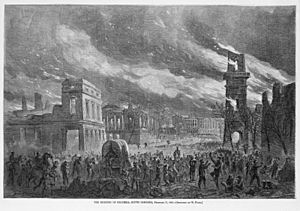Capture of Columbia facts for kids
Quick facts for kids Capture of Columbia |
|||||||
|---|---|---|---|---|---|---|---|
| Part of the Campaign of the Carolinas | |||||||
 The Burning of Columbia, South Carolina, on February 17, 1865, as depicted in Harper's Weekly |
|||||||
|
|||||||
| Belligerents | |||||||
| Commanders and leaders | |||||||
| Strength | |||||||
| 60,000 | ~500 | ||||||
The capture of Columbia happened on February 17–18, 1865. It was a key event during the Carolinas Campaign of the American Civil War. Union forces, led by Maj. Gen. William T. Sherman, took control of Columbia. This city was the capital of South Carolina. A large part of Columbia was burned during this time. It is still debated today who exactly caused the fires.
Contents
Why Was Columbia Captured?
Sherman's March to the Sea and Beyond
After his famous "Sherman's March to the Sea" ended with the fall of Savannah, Georgia, Maj. Gen. William T. Sherman had a new plan. He turned his armies north. His goal was to join up with Lt. Gen. Ulysses S. Grant in Virginia. He also wanted to cut off General Robert E. Lee's supply lines. These lines connected Lee's army to the southern states.
Sherman's Strategic Plan
Sherman planned to march through South Carolina. His first major target was Columbia. After that, he aimed to capture and destroy the Confederate arsenal in Fayetteville, North Carolina. Finally, he would meet up with another Union army group, the XXIII Corps, in Goldsboro, North Carolina. To confuse the Confederate forces, Sherman split his army. One part went west towards Augusta. The other part went east towards Charleston.
Confederate Defenses and Challenges
Confederate forces in South Carolina were part of the Department of the West. General P.G.T. Beauregard was in charge. He tried to defend both Augusta and Charleston at the same time. He divided his soldiers between these two cities. He hoped this would slow Sherman down. Beauregard also thought he could bring his forces back together if Sherman decided to go for Columbia.
The Capture of Columbia
Sherman's Arrival and Confederate Retreat
Sherman's army moved faster than General Beauregard expected. They reached Columbia on the afternoon of February 16. Only a small number of Confederate soldiers were defending the city. These included cavalry units led by Maj. Gen. Joseph Wheeler and Maj. Gen. Matthew Butler. There were also soldiers from Lt. Gen. Stephen D. Lee's corps.
Because they were greatly outnumbered, Lt. Gen. Wade Hampton decided to leave the city. He ordered his troops to evacuate without a fight. However, they destroyed all the bridges over the Congaree and Saluda Rivers. This was an attempt to slow down the Union forces.
The Burning of Columbia
Sherman's troops entered and took control of Columbia the next day. A large part of the city was destroyed by fire. This event has caused much debate ever since. Some people say the fires started when Confederates set fire to cotton bales in the city. Others believe that some Union soldiers, seeking revenge, caused fires. A few witnesses also claimed that some fires started by accident.
Historian James W. Loewen studied this event for his book, Lies Across America. He found that the cotton bale fires likely spread and caused most of the damage. He also noted that some fires were started by Union soldiers, but these caused less destruction. It is most likely that the Confederates' own "scorched earth" policy, where they destroyed things to prevent them from being used by the enemy, was the main reason for the burning of Columbia.
How Much of Columbia Burned?
Reports from that time said that "as much as two-thirds of Columbia was destroyed." However, later studies suggest the actual damage might have been less. We may never know the exact amount of damage. But it is clear that the fires destroyed important government, military, and transportation buildings. They also destroyed businesses, schools, churches, and homes. The memory of this loss became a big part of the city's history and stories about the war. It is still a topic of strong discussion today.

